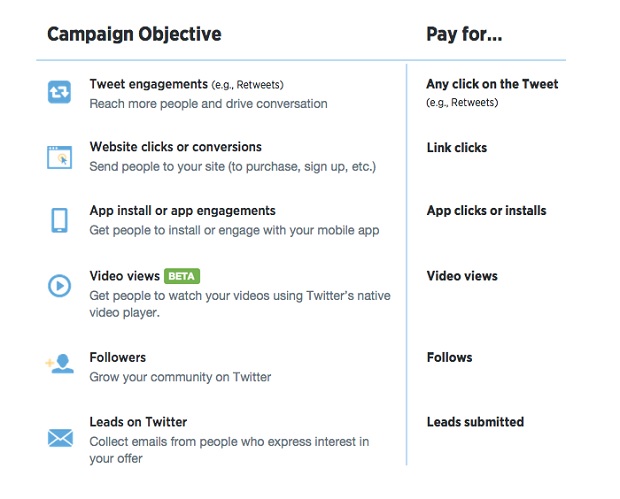Twitter is expanding its advertising offering, letting users decide to pay for their adverts based on whether or not they achieve their objectives, rather than simply paying per view.
The new ad scheme, called objective-based campaigns,lets advertisers pay only for certain types of engagement, such as like website clicks, conversions, lead generation or video views.
Intially launched as the beta program last year, the idea behind the scheme is to let brands focus on specific goals like increasing followers, driving more clicks or pushing more app installs.
Advertisers using the feature are only charged for engagements they target. For instance if they are pursuing more clicks back to their site, all retweets or favorites are free.
There are six objectives available: tweet engagements, website clicks or conversions, app installs or engagement, followers, leads and video views (a beta offering that has been added to the mix since the original rollout in August).
In a blog post announcing the move, Twitter said businesses who have used the campaigns have increased the efficiency of their advertising on Twitter, driving better results at lower costs. Among the examples: eBay’s use of Website Cards to drive referral traffic produced a 59% quarter over quarter decrease in average paid cost per click and digital agency Gupta Media seeing a 24% conversion rate, double the average it gets on other advertising platforms, for its music industry-based campaigns.
Jaguar Land Rover also had success, according to Raunak Munot, the director of social strategy for Mindshare (GroupM), the agency that managed a campaign for the car company.
“In adaptive marketing, it’s key to tailor messages to the users’ varying motivations by utilizing different media types that encourage them to take the next step in the funnel,” Munot said in a quote on Twitter’s blog post. “With Twitter’s objective-based pricing, we only pay for actions that we care about. This has driven down costs and increased efficiencies, especially when driving shoppers to the website to take an action like filling out a request for quote form.”
